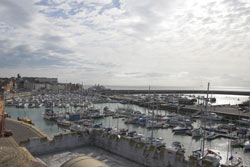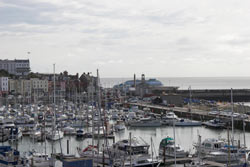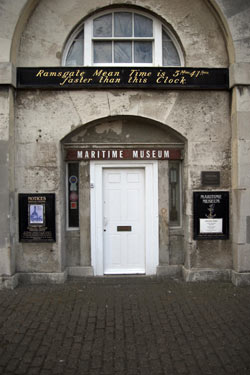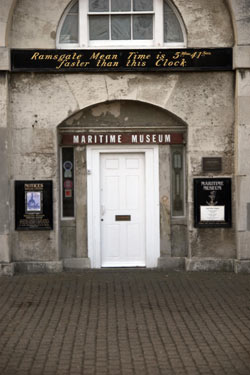Tamron SP AF 17-50mm f/2.8 XR LD Aspherical (IF) Di11
This fast standard zoom lens from Tamron is their entry into the superior performance, standard zoom built for cropped sensor category. With an aperture that opens to f/2.8 and an image circle that is suitable only for APS-C ‘cropped’ sensors, we take a look at how it performs.
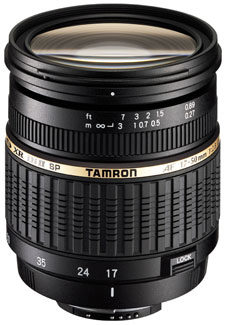 Specifications
Specifications
- Focal Length 17-50mm
- Max aperture f/2.8
- Min aperture f/32
- Construction 16/13 elements/groups
- Min focus 0.27m
- Filter size 67mm
- Size 74x81.7mm
- Weight 0.434kg
- Mount Available Canon, Nikon, Sony
- Price (SRP) £349.99
Build and handling
This lens is well built and specified for its ilk although it lacks the silent smoothness of autofocus by sonic motor. The bulk of the main barrel is taken up with the zoom ring, which is quite nicely torqued in its operation. The travel from the 17mm mark to the 50mm one is almost exactly a quarter of a turn and that extends the front element by some 30mm, although it does not rotate the front element. A zoom lock is provided to stop this extension during transport, although it was not needed with the lens being new. Forward of the zoom ring is a manual focus ring that has a distance guide marked on it. The (IF) in the long-winded title means internal focus, overcoming any physical change in the lens during the focussing operation.
The AF mechanism is a little whiny, although not obtrusively so, and accurate although it takes a couple of small jerks to get there in low light. The finish is a good standard and not as plasticy as some of Tamron’s older offerings.
Optical quality
With modern lenses, standards are rising all the time and this lens has managed to keep up. The resolution is quite good, especially when closed down by a stop and it is fairly consistent across the frame and, surprisingly, throughout the zoom range with neither one end or the other being noticeably better than the other.
The control of CA is exceptionally good with even Imatest struggling to find any at most apertures and focal lengths. There were measurably incidences at the widest apertures, but they were well below the threshold where they might become visible to the eye.
The only place where the lens lets itself down is in the control of distortion. At the longer 50mm end it is within the parameters of acceptability with a pincushion reading of 0.62% but at the wide end of 17mm it has jumped to a rather noticeable 4.39% barrel which is very noticeable. Fortunately it is one of the easier problems to solve in software.
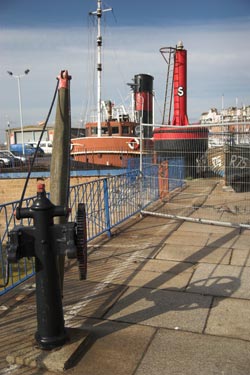 f/2.8 and 23mm were the settings for this image, shot on a Canon 20D | 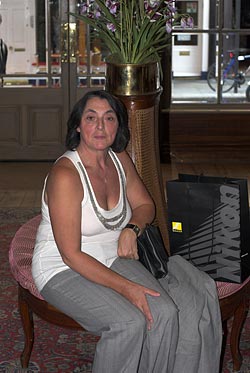 At the 50mm end the lens, fitted on the cropped sensor cameras it is designed for, makes a passable portrait lens. |
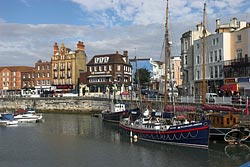 | This time a setting of 30mm at f/5.6 keeps everything sharp. Canon 20D |
Click on each comparision photo below to view full size versions
Below is our lens test data. To find out how to use these graphs look at this article: How we test lenses
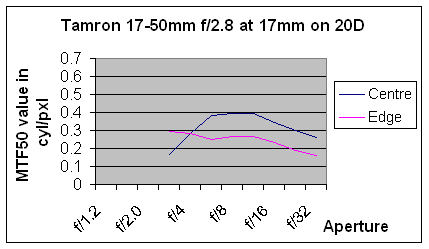
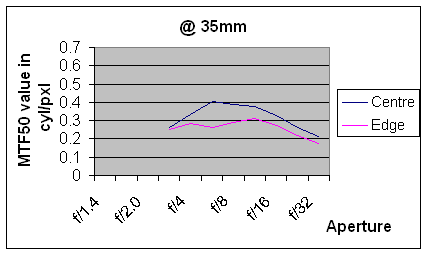
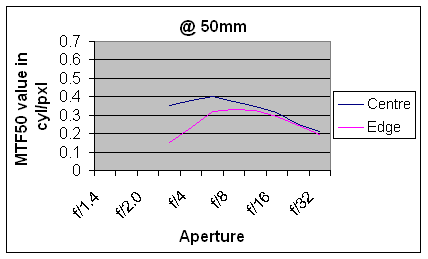
Verdict
With the exception of the distortion at the wide end, this is a very competent lens and a considerable jump up from the general standard of kit lens that it would replace. There is little else that lets it down and good resolution across the frame that is acceptable even when the lens is used wide open commend it. The only other place it could be improved is in the autofocus system where Tamron really do need to get a sonic motor.
In summary, the positive points of the SP AF 17-50mm f/2.8 XR Di11 are:![]() Good resolution and control of CA
Good resolution and control of CA![]() Nice build, an improvement for Tamron
Nice build, an improvement for Tamron![]() Consistent through the focal range
Consistent through the focal range
The negative points are:![]() Distortion at the wide end.
Distortion at the wide end.![]() No supplied case or pouch.
No supplied case or pouch.
Check the latest price for the Tamron 17-50mm f/2.8 Di11 here
Discuss this lens and other related lens subjects here
Test by Ian Andrews www.wildaboutkent.com
What bugs me most is that searching around I cant find ANY test shots of the museum door that ARE sharp edge to edge from any lens.
Thats really scary. I often cannot read the notices in the middle and often the big letters become more blurred towards the edges. And the corners of this stone building are almost never sharp. We're not talking the hairs on someones chin, but BIG stones and mortar and foot high letters, so I just hold off buying, theres nothing being made worth having!!
Sold it few months after.
A true piece of garbage as far as optics go.
It was so soft that even when stoped down to f5.6 the images seemed as they were shot with soft focus filter #4
At f2.8 there were simply all blurry unusable pictures
Buy the Tamron 28-75mm f2.8 (much better lens)if you don't have much money and need to have constant f2.8
But your best bet is to get Nikkor or Canon glass
If you shoot Nikon than I would get the 35-70mm f2.8 which is tack sharp even wide open for about the same price used
And use your kit lens for your wide shots.
I think this is a little pretty lens if you do not need the Canon IS, though I need the IS and so I have both the EF-S17-55IS and this Tamorn.
I mostly use this Tmaorn for travel light or day time , after getting this , I sold the EF50 f1.4 since my Tmaorn is as sharp as the prime if not sharper.
So highly recommended.
The dilemma for me is that it appears the only way to get excellent photos from Canon and Nikon is to spend big bucks on their high-end lenses. I was/am hoping this Tamron model offers some potential for obtaining a quality lense that doesn't break one's bank account.
I may opt out on Canon and Nikon as options for developing an affordable, decent system because they both are more expensive than I will afford. I will probably go with the Olympus E-510 which has better kit lenses than Nikon or Canon and for a whole lot less money.
I am concerned about some of the idiosynchrasies of the E-510, but am willing to try to work around them just because of the high cost of Canon and Nikon glass. Part of the problem is that the zoom ranges for quality lenses from Canon and Nikon make it difficult to cover a breadth of focal lengths unless you buy a minimum of three lenses. For instance, if I had the bucks, I'd buy the Canon 16-35, 24-70 and 70-200 L/F4 IS, but that's not going to happen.
As it is now, I'm probably going to go with Olympus's 14-54 (28-108 equiv.), which is not much more expensive than the Tamron model, the 40-150 kit lens (80-300 equiv.), and get their 50mm F2 macro to round it out. All of that for about $1800 versus $2800 to $3000 for Canon or Nikon systems that would incorporate, say, a Canon 30D or a Nikon D80, and a mix of their respective, better than average lenses.
If I could find one of the good Japanese Tamron 17-50 lenses for a 30D body, I might then pony up the bucks for the Canon 70-200 L/F4 IS and also their prime 60mm macro. I could get away with that system for about $2700, but that's still about a grand more than the Olympus entry level system described above.
Olympus eventually will come out with an improved model of the E-500--E-410--E510 series, superceding the E-510. I'd keep the E-510 for a second body and pick up the new model for my primary system.
Whatever . . . decisions, decisions . . . trade-off after trade-off . . .
Cause i was planning on getting one of those but now my hopes are all turned around, the sample pictures do indeed look rather soft!! :S
I do a lot of close up photography as well as landscapes and this lens on my T1i is awesome.
I see many complaints about build quality which puzzles me. What do you expect for a $400 lens. If they put this glass in a tin can, I would buy it.
Add your message
Please login here or if you've not registered, you can register here. Registering is safe, quick and free.
photodo Stats
428 MTF tests
74 in-depth photodo reviews
100+ users join each day
Help the lens community by reviewing or rating a lens today via our lens search
Latest Lens Reviews
- Chinon 28mm f/2.8 Vintage Lens Review
- Canon EF 70-200mm f/4L IS II USM Lens Review
- Samyang AF 85mm f/1.4 EF Review
- Sigma 70mm f/2.8 DG Macro Art Review
- Samyang AF 24mm f/2.8 FE Review
- Meike 50mm f/1.7 Review
- Tamron 70-210mm f/4 Di VC USD Review
- Lensbaby Burnside 35mm f/2.8 Review
- Asahi Super Takumar 50mm f/1.4 Review
- Asahi Super-Multi-Coated Takumar 135mm f/3.5 Review
